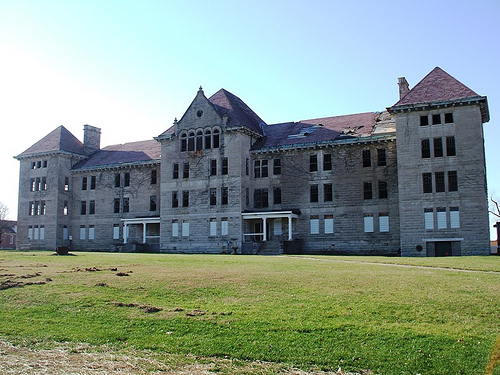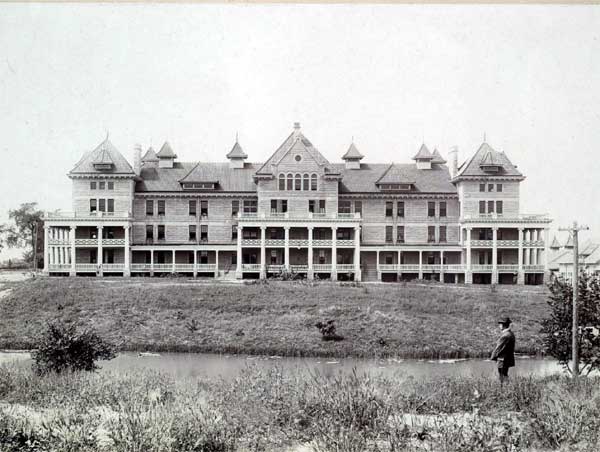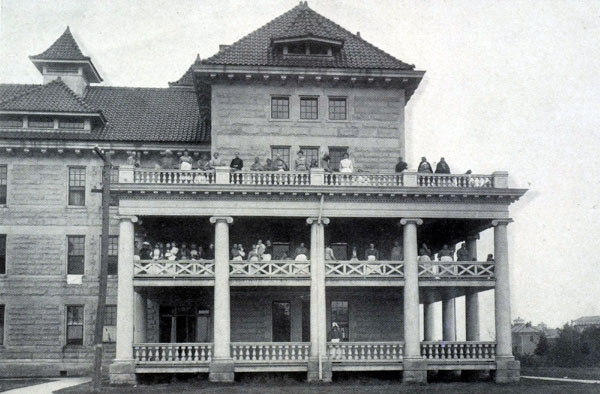

Location: Ricketts Ave and US 24, Bartonville, IL Map
Constructed: 1895-1910
The Peoria State Hospital, also known as Bartonville State Hospital or the Illinois Asylum for the Incurable Insane, was a psychiatric hospital in Bartonville, Illinois, near Peoria, operating from 1902 to 1973. Its history reflects both progressive mental health reforms and the challenges of institutional care, set against a backdrop of architectural evolution, paranormal lore, and community efforts to preserve its legacy.
The Peoria State Hospital was established following the Illinois
General Assembly’s 1895 legislation to create the Illinois Asylum for
the Incurable Insane, aimed at relieving overcrowded county almshouses
where 2,985 “incurable” patients were held, often in deplorable
conditions. Governor John Altgeld appointed a three-person commission,
led by Peorian John Finely and including J.J. McAndrews (later a U.S.
Congressman), to select a site. Bartonville, near Peoria, was chosen,
and construction began in 1895.
The initial main building,
completed in 1897, was designed by architects Reeves and Baillie in the
Kirkbride Plan, resembling a feudal castle. However, it was never used
due to structural issues from abandoned mine shafts beneath, which
compromised its foundation. A 1927 hospital history offers an
alternative explanation, stating the castle-like design was “out of
harmony with modern ideas for the care of the insane” and was razed.
Under Dr. Frederick Howard Wines, the facility was rebuilt using a
cottage system, completed in 1902 under superintendent Dr. George A.
Zeller. This system prioritized smaller, community-like buildings over
large, imposing structures.

The Peoria State Hospital adopted a cottage plan, a progressive
departure from the monolithic Kirkbride asylums. By 1902, the campus
included 33 buildings, growing to 63 at its peak. These included:
Patient and caretaker housing: Small cottages fostered a
home-like environment.
Support facilities: A store, bakery,
kitchen, power station, and communal utility building made the
campus self-sufficient.
Specialized units: The Pollak
Tuberculosis Hospital, a nurses’ dorm, and a training school (opened
in 1906) were key components.
The campus was designed to be
parklike, with sprawling grounds and four cemeteries for
unidentified deceased patients, reflecting Dr. Zeller’s burial
system. The Bowen Building, a central administration and nurses’
dorm, was a prominent limestone structure until its demolition in
2017. The cottage system aligned with Zeller’s humane treatment
philosophy, emphasizing dignity and community over confinement.
The hospital opened on February 10, 1902, receiving 100 male
patients transferred from Jacksonville State Hospital. Initially
named the Illinois Asylum for the Incurable Insane, it was renamed
the Illinois General Hospital for the Insane (1907–1909) and then
Peoria State Hospital in 1909, reflecting its proximity to Peoria
and Zeller’s rejection of the “incurable” label.
Dr. George
A. Zeller, superintendent from 1902–1913 and 1921–1935, was a
pivotal figure. Influenced by the Peoria Women’s League, which
advocated for better mental health treatment, Zeller implemented
groundbreaking reforms:
Open-door policy: He removed bars
from windows and doors, eliminated restraints, and banned narcotics,
solitary confinement, and abusive practices like bloodletting or ice
baths.
Holistic therapies: Zeller introduced occupational
therapy, recreation, and work programs, believing mental illness
could be treated humanely.
Staff innovations: The hospital
adopted an eight-hour workday, placed women attendants on male
wards, and segregated patients with tuberculosis or epilepsy.
Public engagement: Zeller invited journalists and community members
to visit, fostering transparency and reducing stigma around mental
illness.
The hospital’s nursing program, established in 1906, was
ranked the nation’s best for 34 of its 36 years. By 1927, the
patient population reached 2,650, with 13,510 total admissions since
opening. At its peak in the 1950s, it housed 2,800 patients. The
hospital performed 94 lobotomies on severe cases but avoided abusive
experimental treatments, maintaining a high cure rate, though its
expense led to funding challenges.

Peoria State Hospital is renowned for its paranormal
stories, particularly the legend of A. Bookbinder, or “Old Book.” A
patient assigned to the burial crew, Old Book reportedly wept under a
“Graveyard Elm” at each interment. After his death, Dr. Zeller claimed
400 staff and patients witnessed Old Book’s ghost mourning at his own
funeral. Zeller documented this and other eerie experiences in his 1920s
book, Befriending the Bereft.
Other reported hauntings include:
Disembodied voices and a woman in white appearing in windows.
A
girl’s ghost in the Bowen Building basement, known for playing with
dolls.
Shadow figures and heavy boots heard in the Men’s Ward.
The
hospital’s paranormal reputation drew attention from Ghost Hunters
(2013, “Prescription for Fear”) and Ghost Asylum (2016), as well as
authors like Sylvia Shults, who wrote Fractured Spirits and Fractured
Souls about its hauntings. The four cemeteries, with over 4,000 burials
(many marked only by numbers), and notable graves like Rhoda Derry
(mistreated before arriving) and Emily Belsher (descendant of Sir
Frances Drake), add to the site’s mystique.
By 1972, the patient population had dropped to 600 due
to deinstitutionalization, budget cuts, and staffing shortages. The
Illinois government’s push to close long-term facilities, combined with
the hospital’s high operating costs, led to its closure in 1973. After
closing, the buildings were auctioned off. Developer Winsley Durand,
Jr., planned to convert them into office spaces, but his bankruptcy left
most structures vacant. Many of the 63 buildings were demolished,
leaving only 13 by 2025, including the Pollak Tuberculosis Hospital. The
Bowen Building was demolished in 2017, despite preservation efforts,
with its limestone blocks sold to recoup costs.
The Village of
Bartonville designated the site a Tax Increment Financing (TIF) district
to encourage redevelopment. Some remaining buildings now house
commercial and industrial businesses.
The Peoria State Hospital Museum, established in 2013
at 4208 W. Pfeiffer Road, Bartonville, is dedicated to preserving the
hospital’s history. Operated by the Mental Health Historic Preservation
Society of Central Illinois, it occupies three of the remaining
buildings and features artifacts like Dr. Zeller’s display case and the
last Peoria State Hospital Utica crib (a controversial restraint
device). The museum offers:
Historical tours: Guided tours of the
grounds, including the four cemeteries, with costumed actors and
slideshows.
Paranormal tours: Nighttime investigations of “hotspots”
using modern and historical equipment.
Events: Annual bazaars, car
shows, and Halloween attractions like the Old State Mine Haunted Trail,
a fictionalized fundraiser.
The museum, led by figures like Arlene
Parr (former hospital librarian), has worked for over 30 years to
maintain accurate historical records. Books like Bittersweet Memories by
Gary L. Lisman and Parr provide personal accounts from patients and
staff, emphasizing the hospital’s human impact. The Alpha Park Public
Library’s podcast, Stories From the Bowen Building, features interviews
with former staff, further documenting the hospital’s legacy.
Peoria State Hospital was a pioneer in humane mental
health treatment, challenging the era’s brutal practices. Dr. Zeller’s
reforms, inspired by the Peoria Women’s League, set a national standard,
with the hospital’s nursing program and cure rates earning acclaim. Its
cottage system and open-door policy were radical, reflecting a belief
that no patient was incurable.
The hospital’s closure highlights
broader issues in mental health policy, particularly the shift to
deinstitutionalization without adequate community support, leaving many
patients vulnerable. Its paranormal lore, while sensationalized,
underscores the emotional weight of its history—thousands lived,
suffered, and died there, often forgotten except in numbered graves.
The preservation efforts, though challenged by demolitions, ensure
the hospital’s story endures. The museum and community initiatives keep
the focus on both the patients’ experiences and Zeller’s vision,
balancing historical education with the site’s eerie allure.
While sources like Wikipedia and the Peoria State Hospital Museum website provide detailed accounts, they may emphasize Zeller’s reforms and paranormal stories over systemic issues, such as the 94 lobotomies or the neglect caused by budget cuts in the 1960s. The narrative of Zeller as a reformer is compelling but risks idealizing the institution, which, despite its advances, was part of a broader system that often failed the mentally ill, especially post-closure. The focus on hauntings, while engaging, can overshadow the real human stories, as seen in Bittersweet Memories. Future research could explore patient records or oral histories to deepen understanding of life at the hospital beyond Zeller’s perspective.